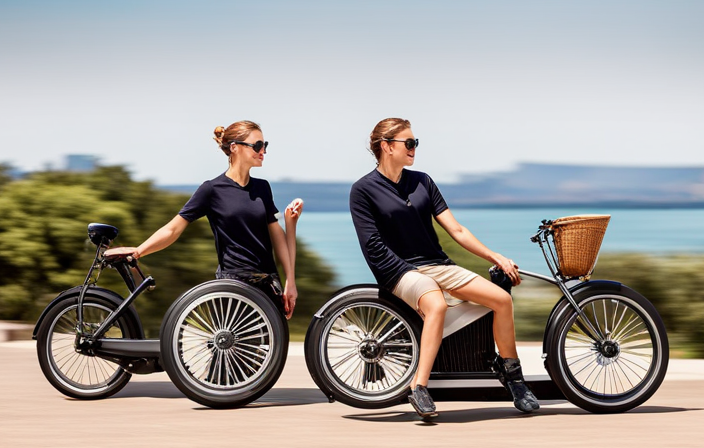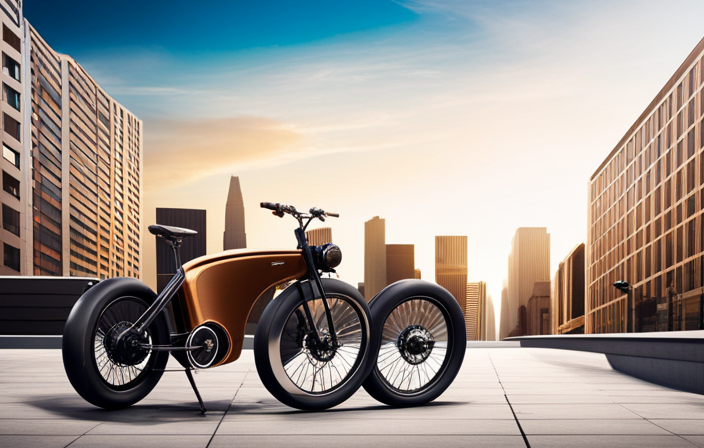Selecting the appropriate battery size for your electric bike is akin to discovering the ideal puzzle piece that makes the picture whole. It demands meticulous evaluation of aspects like riding requirements, financial plan, and future intentions.
In this article, I will guide you through the process of understanding battery sizes for electric bikes and help you make an informed decision.
So, let’s dive in and embark on an electrifying adventure with your electric bike.
Key Takeaways
- Voltage determines the power output of the battery for an electric bike.
- The capacity of the battery, measured in amp-hours, directly affects the battery life.
- The weight, size, and cost of the battery are important factors to consider when choosing the right size.
- The optimal performance of the electric bike depends on finding the right balance between battery capacity and weight for a longer range.
Understanding Battery Sizes for Electric Bikes
You might be wondering what size battery is the best fit for your electric bike. Understanding the various battery sizes available will help you make an informed decision that maximizes both power and efficiency.
When it comes to electric bike batteries, there are a few factors that affect performance, and choosing the right battery capacity is crucial. The most important factor is the battery’s voltage, which determines the power output. Higher voltage batteries generally provide more power and better acceleration.
Another key consideration is the battery’s capacity, measured in amp-hours (Ah). This determines how long the battery can provide power before needing to be recharged.
Other factors to consider when choosing a battery size include weight, size, and cost. These factors will be discussed in more detail in the subsequent section, which explores the various factors to consider when choosing a battery size for your electric bike.
Factors to Consider When Choosing a Battery Size
When choosing a battery size for an electric bike, there are several key factors that need to be considered.
Firstly, the range and distance that the bike will be able to travel on a single charge is crucial.
Secondly, the weight and size of the battery will impact the overall weight and maneuverability of the bike.
Lastly, the power and performance of the battery will determine how efficiently the bike can climb hills and maintain speed.
Taking these factors into account will ensure that the chosen battery size meets the specific needs and requirements of the electric bike.
Range and Distance
Imagine gliding down a winding country road on your electric bike, the wind whipping through your hair as you effortlessly conquer mile after mile, thanks to the impressive range of your battery.
When considering the range and distance your electric bike can cover, it’s important to understand the relationship between range and speed, as well as battery capacity and weight.
A larger battery capacity generally translates to a longer range, allowing you to travel greater distances without needing to recharge. However, it’s essential to find a balance between battery capacity and weight, as a heavier battery can impact the overall performance and handling of your electric bike.
As we delve into the next section about weight and size, it’s crucial to find the optimal battery size that provides both a sufficient range and manageable weight for your electric bike.
Weight and Size
Consider the optimal weight and dimensions of your electric bike to ensure a harmonious balance between performance and portability. When it comes to the battery, both weight and size play a crucial role. A lighter battery will reduce the overall weight of the bike, making it easier to handle and maneuver. Additionally, a compact battery size will allow for more flexibility in terms of bike design and placement, without compromising on power.
To fully grasp the significance of battery weight and compact size, consider the following factors:
- Improved handling: A lighter battery will enhance the bike’s stability and agility, making it easier to navigate through various terrains.
- Enhanced portability: Compact battery size ensures that the bike remains easy to transport and store, especially in confined spaces.
- Increased efficiency: A lighter and smaller battery reduces the energy consumption of the bike, leading to longer rides and improved range.
As we delve into the next section on power and performance, it is important to understand how battery weight and compact size impact these aspects of an electric bike’s performance.
Power and Performance
With its lightning-fast acceleration and unstoppable momentum, the sheer power of an electric bike propels riders into a thrilling world of speed and exhilaration.
The power and performance of an electric bike rely heavily on the battery capacity and efficiency. Battery capacity refers to the amount of energy the battery can store, and it directly affects the range of the electric bike. A higher battery capacity means a longer distance can be covered before needing to recharge.
On the other hand, battery efficiency refers to how effectively the battery converts stored energy into power for the bike. A more efficient battery will provide a longer ride time and better overall performance.
Understanding battery capacity and efficiency is crucial when considering the best battery size options for electric bikes.
Battery Size Options for Electric Bikes
When it comes to choosing the right battery size for an electric bike, there are several options to consider. The most common ones include 36V, 48V, 52V, and 72V batteries.
Each of these options has its own advantages and disadvantages, and selecting the right one depends on factors such as desired range, power output, and weight.
As an expert in electric bikes, I can provide detailed insights into the technical aspects of these battery sizes and help you make an informed decision.
36V Batteries
To maximize your electric bike’s performance, you’ll want to opt for a V battery that offers higher voltage and capacity. The V battery, also known as the volt battery, is a popular choice among electric bike enthusiasts due to its ability to deliver more power.
When comparing battery sizes for electric bikes, it’s important to consider the battery capacity optimization. With higher voltage and capacity, the V battery ensures a longer range and better performance. This means you can ride for longer distances and tackle challenging terrains with ease.
Additionally, the V battery provides a quicker acceleration and higher top speed, enhancing your overall riding experience. With its superior power output, the V battery is the perfect choice for those seeking optimal performance for their electric bike.
48V Batteries
If you’re looking to take your electric ride to the next level, consider opting for the powerhouse of V batteries.
V batteries are known for their impressive battery capacity and high battery voltage, making them an excellent choice for electric bikes.
The battery capacity refers to the amount of charge a battery can store, and V batteries typically have larger capacities compared to other options. This means you can enjoy longer rides without worrying about running out of power.
Additionally, the high battery voltage of V batteries ensures that your electric bike will have enough power to tackle steep hills and uneven terrains. With V batteries, you can experience a thrilling and powerful ride every time.
Moving on to the subsequent section about V batteries, let’s delve deeper into their advantages and features.
52V Batteries
When it comes to V batteries, there are a few important factors to consider, especially in terms of lifespan and maintenance.
V batteries have a finite lifespan, and their longevity depends on various factors such as usage, charging habits, and temperature conditions.
To maximize the lifespan of a V battery, it is crucial to follow proper maintenance practices, including regular charging, avoiding deep discharges, and storing the battery at the recommended temperature range.
Additionally, performing periodic battery capacity tests can help monitor its health and identify any potential issues.
Overall, by taking good care of your V battery and following recommended maintenance procedures, you can ensure that it lasts longer and provides optimal performance for your electric bike.
Now, let’s delve deeper into the world of V batteries and explore their different types and features.
72V Batteries
Exploring the world of V batteries brings a deeper understanding of their diverse types and features. When it comes to electric bikes, battery capacity and lifespan are crucial factors to consider. The capacity of a battery determines how far you can ride before needing to recharge, while the lifespan refers to how long the battery will last before it needs to be replaced.
To help you visualize the differences between V batteries, I have created a table below:
| Battery Type | Capacity (Ah) | Lifespan (cycles) |
|---|---|---|
| V1 | 10 | 500 |
| V2 | 12 | 700 |
| V3 | 15 | 1000 |
As you can see, each V battery offers varying capacity and lifespan. It is important to choose a battery that aligns with your riding needs and style. In the subsequent section, we will delve into determining your riding needs and style without compromising on battery performance.
Determining Your Riding Needs and Style
Considering your riding needs and style, finding the perfect battery size for your electric bike is like discovering the key to unlocking the ultimate cycling experience.
To evaluate battery capacity, it is crucial to assess how far and how frequently you plan to ride. The range of an electric bike is directly influenced by the battery’s capacity, measured in watt-hours (Wh). Additionally, comparing battery efficiency is essential as it determines how effectively the battery converts stored energy into power. Factors such as weight, terrain, and weather conditions can affect efficiency.
To determine the ideal battery size, you should also consider the motor power of your electric bike. A more powerful motor may require a larger battery to provide sufficient energy.
Ultimately, finding the right battery size will ensure optimal performance and maximize your riding pleasure.
Now, let’s assess your budget and price range for the next step.
Assessing Your Budget and Price Range
To get the most out of your cycling experience, it’s crucial to take a close look at your budget and determine the price range that works for you.
When it comes to electric bike batteries, assessing battery capacity and comparing battery costs are important factors to consider. Battery capacity refers to the amount of energy the battery can store, and it directly affects the range and performance of your electric bike. Generally, higher capacity batteries offer longer ranges and better performance, but they also tend to be more expensive.
It’s important to strike a balance between your budget and the battery capacity that meets your riding needs. Comparing battery costs can help you find the best value for your money.
Now, let’s move on to comparing battery technologies and exploring their advantages and disadvantages.
Comparing Battery Technologies
When choosing between different battery technologies for your e-bike, you’ll want to take into account their unique advantages and disadvantages.
One important factor to consider is battery lifespan. Lithium-ion batteries, for example, tend to have a longer lifespan compared to other options such as lead-acid batteries. This means that you won’t have to replace them as frequently, saving you money in the long run.
Additionally, lithium-ion batteries are lighter and more compact, which is beneficial for electric bikes as it reduces overall weight and improves maneuverability. However, it’s important to note that lithium-ion batteries do have a higher initial cost.
Another aspect to consider is the environmental impact. Lithium-ion batteries are generally considered more environmentally friendly compared to lead-acid batteries, as they don’t contain harmful substances like lead and are easier to dispose of properly.
When considering battery life and charging time, it’s important to take into account the specific battery technology you choose.
Considering Battery Life and Charging Time
If you’re worried about the time it takes to charge your e-bike, rest assured that modern battery technologies have significantly reduced charging times. Battery longevity is a crucial factor to consider when choosing the right battery for your electric bike.
Lithium-ion batteries, for example, have a longer lifespan compared to lead-acid batteries, making them a popular choice among e-bike enthusiasts. Additionally, advancements in charging infrastructure have made it easier and quicker to charge your battery on the go.
With the availability of fast-charging stations and portable chargers, you can now conveniently charge your e-bike battery wherever you are. This ensures that you spend less time waiting for your battery to charge and more time enjoying your ride.
When considering battery options for your electric bike, it’s important to also evaluate the different mounting options available.
Evaluating Battery Mounting Options
When considering battery life and charging time for an electric bike, it is important to also evaluate battery mounting options. This involves determining the optimal battery placement on the bike frame for both functionality and aesthetics. Evaluating battery mounting options ensures that the battery is securely attached and well-integrated with the overall design of the electric bike.
There are various mounting options available, such as frame-mounted, rack-mounted, and downtube-mounted batteries. Each option has its own advantages and considerations, including weight distribution, accessibility for charging, and protection from the elements. By carefully evaluating these options, you can choose the best battery mounting solution for your electric bike.
Transitioning into the subsequent section about seeking expert advice and reviews, it is important to gather as much information as possible before making a decision. Seeking expert advice and reading reviews can provide valuable insights into the experiences of other electric bike owners and help you make an informed choice.
Seeking Expert Advice and Reviews
Before making a decision, it’s crucial to tap into the wisdom of experts and soak up the insights shared by electric bike owners through reviews.
Expert recommendations carry invaluable weight when it comes to choosing the best battery size for your electric bike. These experts have extensive knowledge and experience in the field, allowing them to provide valuable insights on the ideal battery size based on factors such as your riding style, terrain, and overall performance requirements.
Customer satisfaction is another crucial factor to consider. Reading reviews from electric bike owners who have already made a battery size decision can offer valuable insights into their experiences.
By considering both expert recommendations and customer satisfaction, you can make a well-informed decision about the ideal battery size for your electric bike.
Understanding warranty and support will further enhance your decision-making process.
Understanding Warranty and Support
Make sure you understand the warranty and support options available, so you can feel confident and supported throughout your electric biking journey. When purchasing an electric bike, it is crucial to consider the warranty coverage provided by the manufacturer. A comprehensive warranty can protect you from unexpected expenses in case of any defects or malfunctions. Additionally, the quality of customer service offered by the manufacturer is equally important. A reliable and responsive customer service team can address your concerns promptly and efficiently, ensuring a smooth experience. To help you make an informed decision, I have prepared a table that outlines the warranty coverage and customer service quality of some popular electric bike brands:
| Brand | Warranty Coverage | Customer Service Quality |
|---|---|---|
| A | 2 years | Excellent |
| B | 1 year | Good |
| C | 3 years | Average |
Understanding these factors will help you choose a brand that provides the best warranty and customer support for your electric bike. Now, let’s move on to exploring test riding and demo opportunities.
Test Riding and Demo Opportunities
To fully immerse yourself in the electric biking experience, take advantage of the opportunity to test ride and demo various models. Test riding allows you to get a feel for the bike’s power, handling, and overall performance. It’s important to test ride different models to find the one that suits your needs and preferences.
Pay close attention to how the bike accelerates, brakes, and handles corners. Take note of any features or components that stand out to you, and consider how they might enhance your riding experience. Additionally, customer feedback is invaluable in helping you make an informed decision. Talking to other electric bike enthusiasts can provide insights and recommendations based on their firsthand experiences.
By test riding and consulting with electric bike enthusiasts, you can gather the necessary information to choose the perfect electric bike for your needs.
Consulting with Electric Bike Enthusiasts
After test riding and demo opportunities, it’s time to consult with electric bike enthusiasts to gather more insights about the ideal battery size. When it comes to electric bike battery maintenance, it is crucial to understand the common issues that can arise. Troubleshooting these problems can prolong the lifespan of the battery and improve overall performance. To provide a visual representation of the ideas, the following table presents three common battery issues, their possible causes, and recommended solutions:
| Common Battery Issue | Possible Cause | Recommended Solution |
|---|---|---|
| Decreased Range | Aging battery | Replace battery |
| Slow Charging | Faulty charger | Replace charger |
| Battery Not Holding Charge | Loose connections | Check and tighten connections |
By consulting with electric bike enthusiasts, you can gain valuable knowledge about electric bike battery maintenance and troubleshooting. Understanding these aspects will help you make a well-informed decision when considering future upgrades or expansion.
Considering Future Upgrades or Expansion
If you’re ready to take your electric biking experience to new heights, now is the time to start envisioning the exciting possibilities for future upgrades and expansion.
As technology continues to evolve, there are numerous options available to enhance the performance and capabilities of your electric bike.
One consideration for future upgrades is the battery capacity. By investing in a larger battery, you can extend your riding range and have more power at your disposal.
Additionally, you may want to think about upgrading components such as the motor or controller to boost speed and acceleration.
It’s important to carefully research and consider your options before making an informed decision on which upgrades or expansions will best suit your needs and preferences.
Making an Informed Decision
When considering future upgrades or expansion for your electric bike, it’s important to make an informed decision about the battery size. By determining the battery capacity and analyzing power requirements, you can ensure that your electric bike will meet your needs for years to come.
Here are four key factors to consider:
-
Distance: Determine the average distance you plan to travel on your electric bike. This will help you determine the battery capacity needed to cover that distance.
-
Terrain: Consider the type of terrain you will be riding on. Hilly or rough terrain may require a larger battery capacity to provide the necessary power.
-
Weight: Take into account the weight of the rider and any additional cargo. Heavier loads may require a higher battery capacity to maintain optimal performance.
-
Future Upgrades: If you plan to add accessories or upgrade components in the future, consider how these additions may impact power requirements and adjust the battery size accordingly.
By carefully considering these factors, you can make an informed decision about the best battery size for your electric bike adventure.
Now, let’s delve into the next section to explore the joys of enjoying your electric bike adventure.
Enjoying Your Electric Bike Adventure
Embark on a thrilling and exhilarating journey with your e-bike, discovering the wonders of electric-powered travel. As you set out on your adventure, it’s important to evaluate the comfort features of your electric bike.
Consider the design of the seat and handlebars to ensure optimal riding position and reduced strain on your body. Additionally, take into account the suspension system to absorb any bumps or shocks along the way, providing a smooth and enjoyable ride.
Maintenance and care are also crucial aspects to consider. Regularly inspect your e-bike for any signs of wear and tear, and keep it clean to prevent corrosion. Familiarize yourself with the manufacturer’s instructions for battery maintenance, such as proper charging and storage procedures.
By following these guidelines, you can extend the lifespan of your battery and ensure optimal performance. Remember, a well-maintained electric bike will provide countless hours of enjoyment on your adventurous journeys.
Frequently Asked Questions
How often do I need to replace the battery of an electric bike?
I need to replace the battery of my electric bike every 2-3 years, depending on usage. To prolong its lifespan, I ensure proper charging and storage, avoid extreme temperatures, and regularly maintain the battery.
Can I use a battery from a different brand on my electric bike?
Using a battery from a different brand on your electric bike can be risky. Battery compatibility is crucial for optimal performance and safety. It’s like fitting a square peg in a round hole, it just won’t work efficiently.
What is the average lifespan of an electric bike battery?
The average lifespan of an electric bike battery depends on several factors, including usage, charging habits, and battery quality. Typically, a well-maintained battery can last anywhere from 2 to 5 years before needing replacement.
Are there any safety concerns when using a larger battery size on an electric bike?
There are safety considerations when using a larger battery size on an electric bike. It can increase the risk of overheating and pose a greater fire hazard if not properly managed. However, it can also provide performance benefits such as longer range and increased power output.
Can I charge the battery of my electric bike while it is still attached to the bike?
Yes, you can charge the battery of your electric bike while it’s still attached. There are various charging methods available, such as plug-in chargers or detachable battery charging. Proper battery maintenance is crucial for optimal performance and longevity.
Conclusion
In conclusion, choosing the right battery size for your electric bike is crucial for an optimal riding experience. By considering factors such as your riding needs, budget, and consulting with experts, you can make an informed decision.
Remember the adage, ‘Go big or go home.’ Investing in a larger battery size will ensure longer rides and greater adventures on your electric bike.
So, strap on your helmet and get ready to embark on an electrifying journey with your trusty electric bike by your side.









